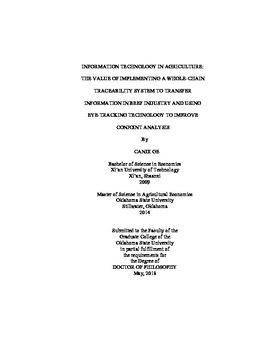| dc.contributor.advisor | Adam, Brian Dale | |
| dc.contributor.author | Ge, Candi | |
| dc.date.accessioned | 2019-05-08T18:57:00Z | |
| dc.date.available | 2019-05-08T18:57:00Z | |
| dc.date.issued | 2018-05 | |
| dc.identifier.uri | https://hdl.handle.net/11244/319633 | |
| dc.description.abstract | Information technology has been widely used in agricultural industries. This dissertation evaluates the benefits of two newly-developed information technologies, whole-chain traceability in the beef industry and eye tracking in the turfgrass industry. | |
| dc.description.abstract | Implementing a whole-chain traceability system (WCTS) in the beef industry may bring many benefits. Chapters II and III focus on the topic of estimating the value of information in a fragmented beef supply chain. The difficulty of transferring information in a fragmented supply chain as in the U.S. beef industry is that animals move through several stages of production and ownership, a price incentive for a specific attribute at the consumer level can be greatly diluted or even nonexistent at the producer level. The value of transferring valuable information, tenderness genetics and injection site information, in this research, and the optimal allocation of compensation to each supply chain participant that provides additional value, are estimated in Chapters II and III. Results indicate that implementing a whole-chain traceability system to transfer tenderness genetics and injection information brings extra profits to supply chain participants. But the value of benefit depends on the actual characteristics of operation actions. | |
| dc.description.abstract | Conjoint analysis is widely used in marketing and consumer research, as it indicates consumers' preferences on products/service. However, the conjoint analysis does not provide much information about the decision-making process. Eye-tracking technology, when combined with conjoint analysis, record consumers' eye movements. Eye movements are good behavioral indicators of visual attention and information acquisition. In Chapter IV, the impacts of including eye fixation data on estimated willingness-to-pay and scale of the variance in the conjoint analysis were studied. When including eye fixation in the logit models, the estimated willingness-to-pay for turfgrass attributes change, but in an uncertain direction. Including eye fixation data also influences the scale parameter. The longer attention received by one choice task, the smaller scale parameter is. Thus, longer fixation on one choice task indicates a more uncertain choice. | |
| dc.format | application/pdf | |
| dc.language | en_US | |
| dc.rights | Copyright is held by the author who has granted the Oklahoma State University Library the non-exclusive right to share this material in its institutional repository. Contact Digital Library Services at lib-dls@okstate.edu or 405-744-9161 for the permission policy on the use, reproduction or distribution of this material. | |
| dc.title | Information technology in agriculture: The value of implementing a whole-chain traceability system to transfer information in beef industry and using eye-tracking technology to improve conjoint analysis | |
| dc.contributor.committeeMember | Chung, Chanjin | |
| dc.contributor.committeeMember | DeVuyst, Eric Allen | |
| dc.contributor.committeeMember | McCann, Melinda H. | |
| osu.filename | GE_okstate_0664D_15769.pdf | |
| osu.accesstype | Open Access | |
| dc.type.genre | Dissertation | |
| dc.type.material | Text | |
| thesis.degree.discipline | Agricultural Economics | |
| thesis.degree.grantor | Oklahoma State University | |
